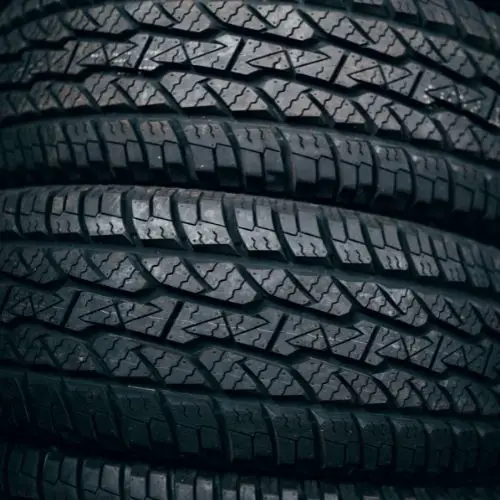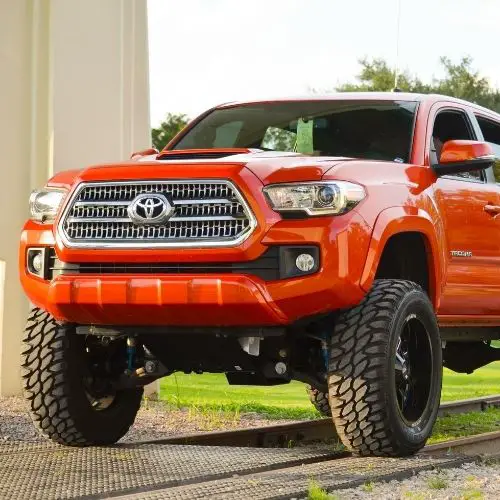We may get commissions for purchases made through links in this post. Thanks for the support! 👍
It is a common misconception that newer tires should be placed on the front of the vehicle. The tire manufacturer’s recommendation is actually to install new tires on the rear axle first when putting four new tires on a vehicle. The reasoning for this has to do with weight distribution, under-steering, as well as the vehicle’s natural tendency to under-steer in a straight line.
Weight distribution

When you put new tires on the front of the car, you are putting more rubber on the ends of your axle which shifts the weight balance forward and can tilt it back onto its rear wheels, making steering and cornering harder for the driver (under-steering or over-steering).
If you put new tires on the front of this vehicle and they have no tread depth, all of the weight will be sitting on the ends of each axle. This causes a heavier load on these ends reducing stability when driving straight as well as making steering more difficult.
When you put the new tires on the rear of this vehicle, it puts less weight on the ends of your axles but makes steering easier. The increased weight on your rear tires will also help you when it comes to accelerating.
The vehicle will have more stability and more traction which makes the driving experience safer for all of us.
Under-steering and overdriving
When the car is under-steering it is easier to handle than when the vehicle over-steers or fishtails. If you put new tires on your front axle first, and they don’t have as much tread depth, there will be more coefficient of friction than the rest of the tires so this increases under-steering. Putting your new tires on the rear axle first makes for better handling in a straight line as well as while cornering both because it reduces under-steering and reduces the chances of fishtailing.
Newer tires are more slippery because they don’t have as much tread depth on them, so putting them on the front of your vehicle will under-steer and over-steer more than if you put them in the rear.

The natural tendency for a straight-line car is to under-steer when driving in a straight line. If you put newer tires on your front axle first, they are more likely to over-steer when turning because there is less weight on the rear of the vehicle. This causes more friction and makes it harder for you to turn which can be dangerous at best and deadly at worst!
However, IIN is referred to as the Instability Index Number (IIN) and is a rating system that applies to all vehicles, including light trucks, SUVs, and vans. An IIN of 0-100 shows the likelihood of a vehicle rolling or flipping over if cornering at 60 mph under ideal conditions:
- 20% or less – Very Stable Rating (Likely to roll or flip)
- 30-60% – Stable Rating (Likely to roll or flip)
- 80-100% – Very Unstable Rating (Very Likely to roll or flip)
By putting the newer tires on the front of a vehicle, your IIN will be higher which means your car is more likely to run off the road if cornering or when making turns. For this reason, it is safer to put the newer tires on the back of your vehicle.
- Top 6 Best Tires for Pickup Trucks (All Categories)
- Leaf Springs: Why do pickups have them?
- Metal Bumpers vs Bumper Covers: Why don’t normal bumpers exist anymore?
- Used Trucks: Are they worth it, and should you buy one?
What about AWD (All-Wheel Drive) vehicles?
If you are looking to keep you budget down, and want to just replace 2 tires on an AWD vehicle, you might want to think again. Most AWD systems will actually become damaged if you don’t replace all of your tires at the same time.
Why is this? Tires wear down over time, which actually makes the circumference of the tire smaller. If you were to replace only one or two of the tires, the newer tires would have a larger circumference and actually will spin slower than the smaller tires.
This will actually cause the AWD system to work incorrectly, and can damage your vehicle’s transfer case and could affect even more.
So what does this all mean?
Bring your car in for an alignment after putting on new tires. Most auto shops will align a vehicle for free if you purchase the parts from them. This is because when you put on new tires, each tire is going to be wearing at a different speed and in different directions than before.
Conclusion
Putting new tires on the front of your car shifts its weight balance forward making it harder to drive straight as well as making steering and cornering more difficult. New tires should be installed on the rear axle first when putting four new tires on a vehicle.
Be sure to check with your tire manufacturer when you’re deciding which tires to pick up for your truck or car so that you know what size and type of tire they recommend for a replacement. If you are to do the tire replacement by yourself, be sure to put on your safety glasses and gloves.


